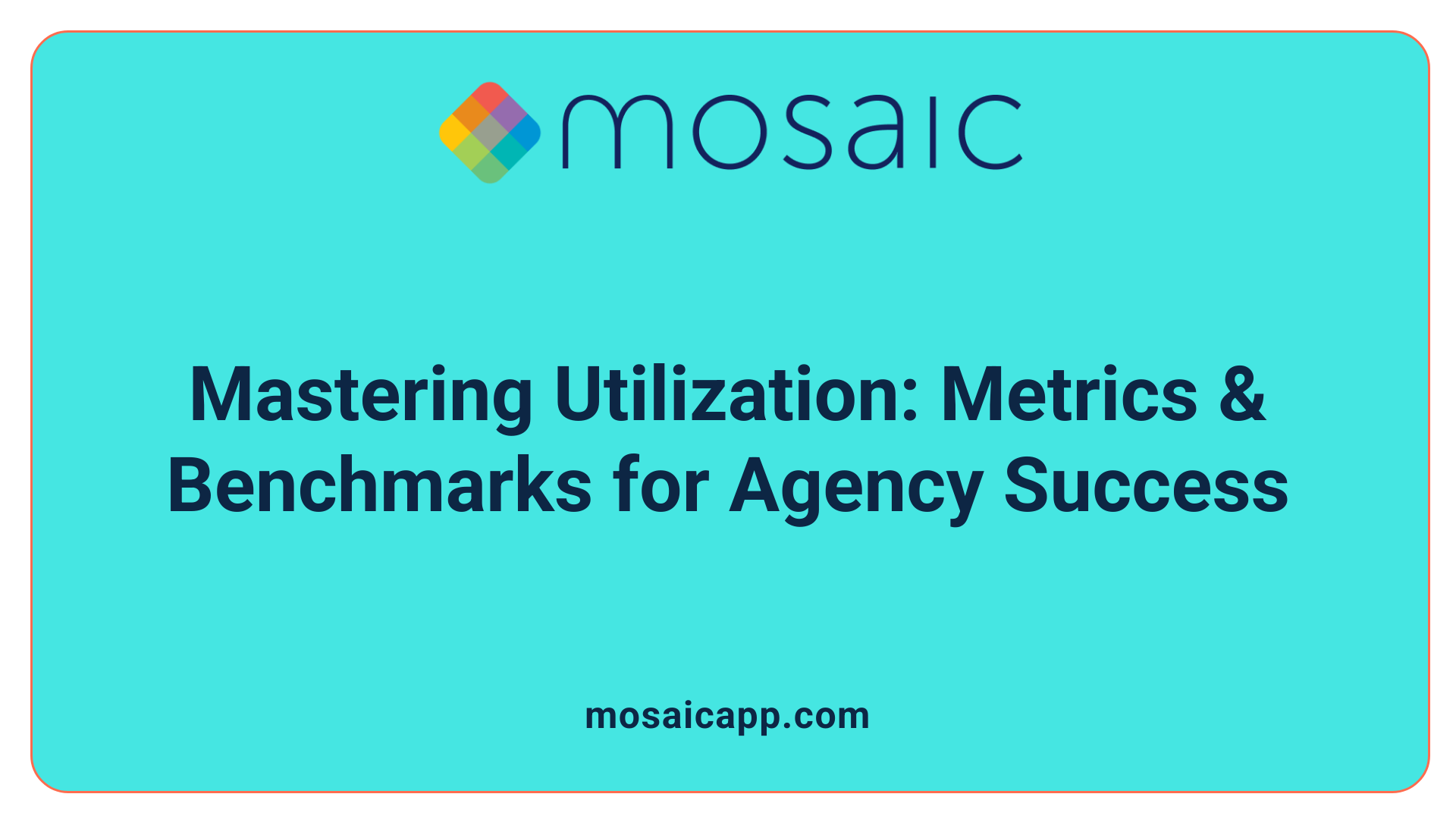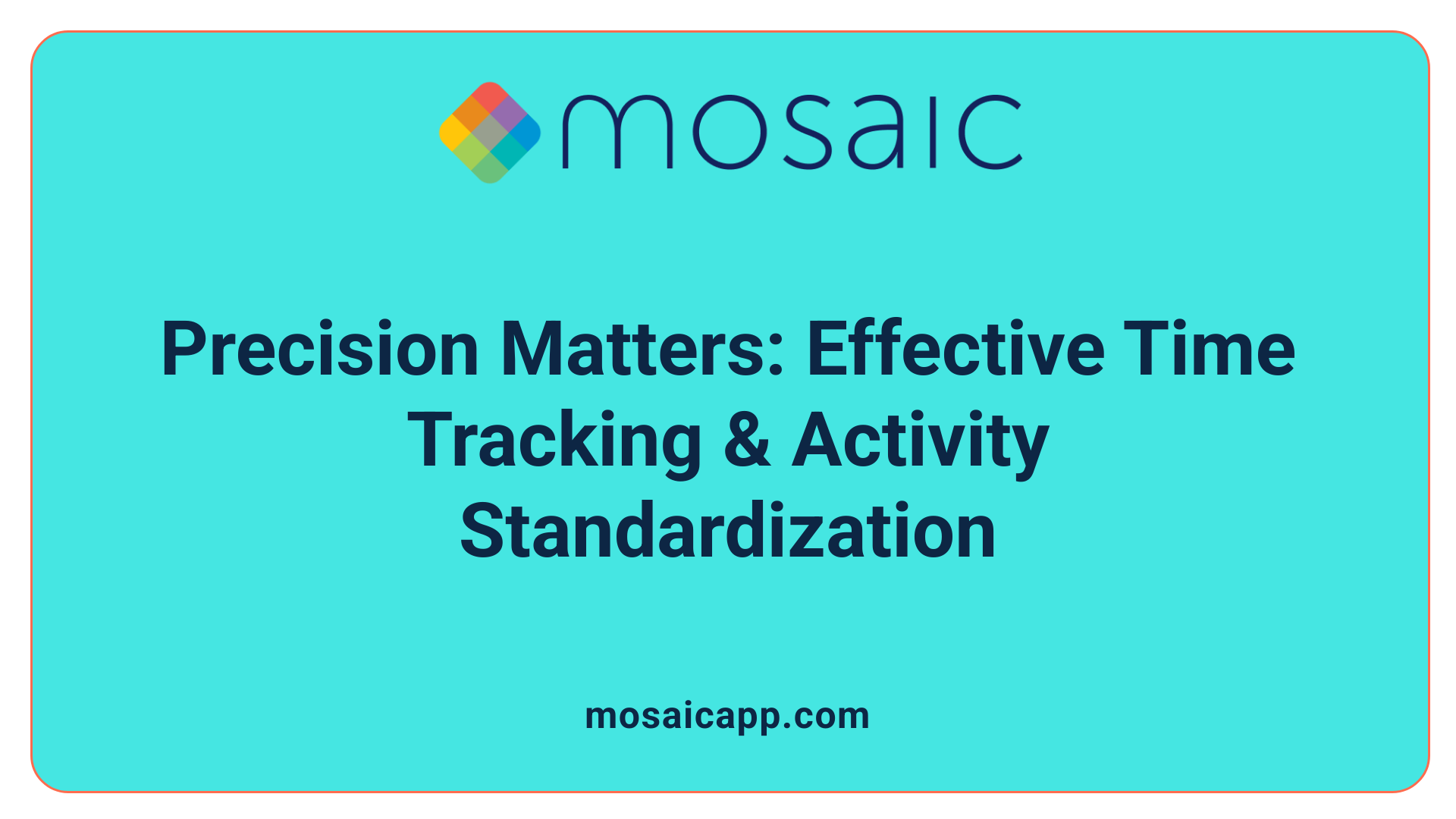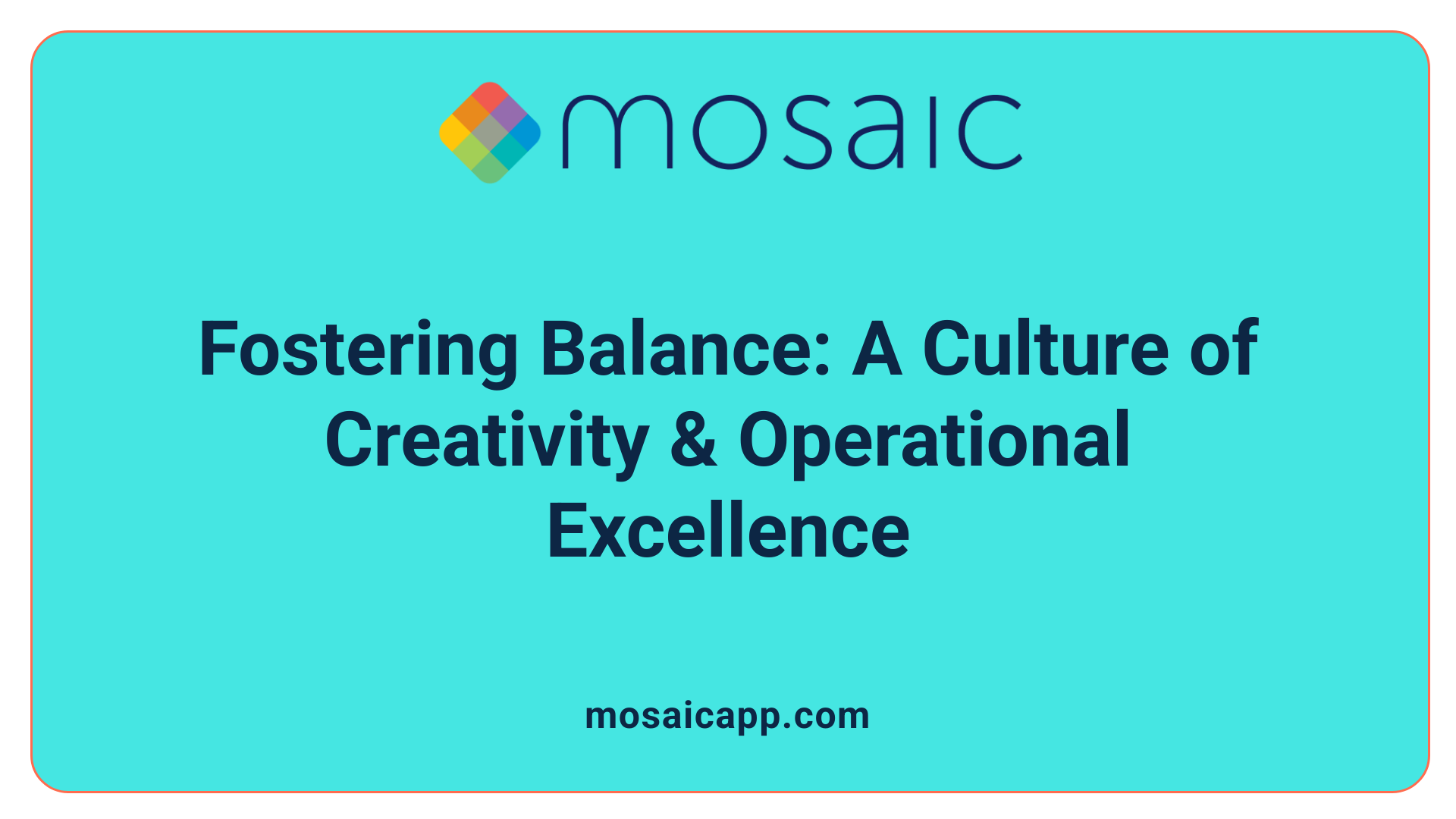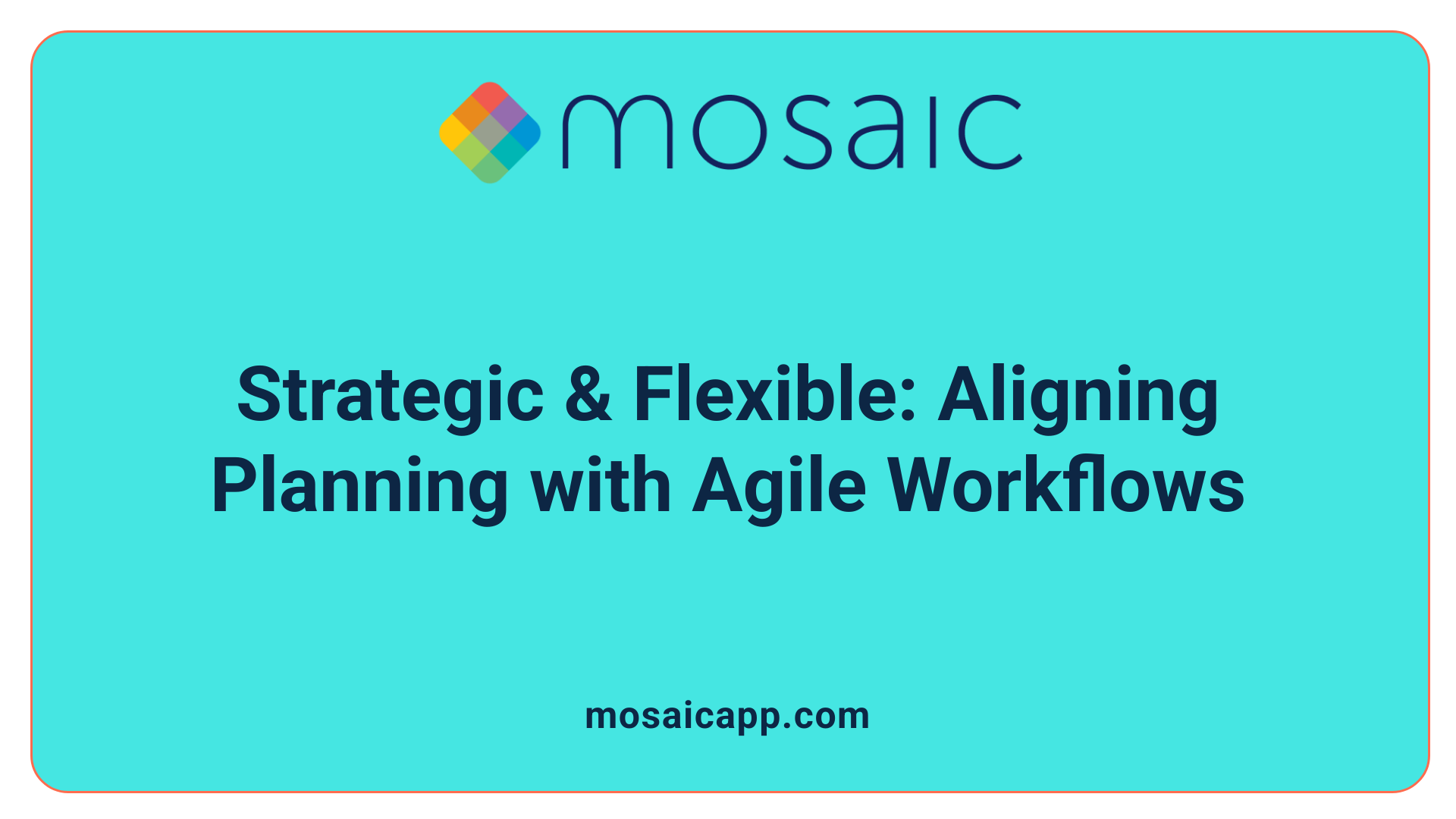Fostering Innovation Without Compromising Efficiency
In today’s competitive and rapidly evolving market landscape, creative agencies face the ongoing challenge of maintaining high utilization rates while nurturing innovation and creative excellence. Balancing these priorities requires strategic operational practices, intelligent resource management, and a culture that values both productivity and creative exploration. This article explores comprehensive approaches, tools, and best practices to help agencies achieve this delicate equilibrium, ensuring sustainable growth and a vibrant creative environment.
Understanding Utilization Metrics and Benchmarks

What is agency utilization and how is it calculated?
Agency utilization, often called billable utilization, measures how much of a team's available working hours are spent on revenue-generating tasks. It is calculated using the formula: (Billable hours / Total available hours) × 100. For example, if a team works 40 hours in a week and 30 of those hours are billable to clients, the utilization rate is 75%. This metric provides clear insight into how efficiently an agency's resources are used.
Available hours refer to scheduled work time each team member has during a specific period. Billable hours are the hours directly linked to client projects that can be invoiced. Regularly tracking these figures helps in understanding the operational efficiency of the agency.
Industry benchmarks across different roles
Different roles within an agency target varying utilization rates based on their responsibilities. For roles focused directly on client work, such as producers and freelancers, the aim is typically between 75% and 80%. Managers generally have a target of 35% to 50%, accounting for their oversight and strategic tasks. Sales and administrative staff often aim for more than 10%, reflecting their support roles.
For creative roles like design and development, the preferred utilization bracket is slightly higher, ranging from 75% to 85%. These benchmarks help agencies set realistic goals and measure performance across diverse functions.
How do utilization rates impact profitability and resource planning?
Maintaining optimal utilization rates is crucial for agency profitability. High utilization, say above 90%, might seem beneficial but can lead to staff burnout and reduce time available for innovation and development. Conversely, low utilization below 60% can signal underutilization, project scope issues, or excessive administrative burdens.
Balancing utilization is essential. A well-managed rate typically hovers around 65% to 75%, aligning with industry averages and supporting sustainable growth. Effective utilization tracking allows agencies to plan capacity accurately, avoid over-servicing, and identify profitable clients and projects.
To optimize resource allocation, agencies use management software that provides real-time insights into utilization. These tools help forecast capacity, guide staffing decisions, and identify when workloads are becoming unbalanced. As a result, agencies can enhance revenue, ensure happier teams, and nurture long-term growth.
| Role | Target Utilization Rate | Typical Range | Importance |
|---|---|---|---|
| Producers & Freelancers | 75-80% | 70-85% | Ensures high revenue delivery without burnout |
| Managers | 35-50% | 30-55% | Balances oversight with strategic planning |
| Sales & Admin | >10% | 10-20% | Supports operational functions efficiently |
| Design & Development | 75-85% | 70-90% | Drives project completion and client satisfaction |
Strategies to improve utilization and agency performance
Effective time tracking is foundational. Tools like Scoro, Toggl Track, and Harvest automate the calculation of utilization rates and provide instant visibility. Clear definitions of what constitutes billable versus non-billable activities enhance tracking accuracy. Standardizing activity categories helps teams document work precisely and consistently.
Reducing non-billable administrative work through regular audits allows more focus on billable tasks. Reevaluating legacy clients with outdated scopes or lower rates can free resources for more profitable projects.
Qualifying clients before project initiation ensures workload aligns with agency capacity, preventing overextension. Establishing dedicated project 'pods' — small, cross-functional teams — improves collaboration and efficiency, thus boosting overall utilization.
Finally, balancing workloads by leaving buffer time for emergencies and creative exploration supports sustained productivity and team well-being. Utilizing resource management software helps visualize workloads, allocate resources strategically, and maintain a sustainable utilization rate.
Understanding and managing utilization rates are central to optimizing agency operations, ensuring profitability, and fostering a productive, innovative work environment.
The Crucial Role of Accurate Time Tracking and Activity Categorization

Why is it important to use simple and integrated time-tracking tools?
Implementing straightforward and cohesive time-tracking tools is essential for maintaining consistent and accurate measurement of billable utilization. When tools like Scoro's 'Bookings' chart or platforms such as Toggl Track, Harvest, and Clockify are easy to operate, teams are more likely to record their hours reliably without frustration or confusion. Automated calculations and real-time data presentation help managers instantly assess utilization rates, identify over- or under-utilization, and make informed decisions.
Furthermore, integrated tools streamline data collection by connecting time tracking with project management, billing, and resource allocation modules. This reduces manual entry errors, saves administrative time, and provides a holistic view of team productivity. Simplified systems also encourage regular usage, leading to more accurate insights and better capacity planning.
Why is standardizing billable versus non-billable activities crucial?
Consistent classification of activities as either billable or non-billable is vital for precise tracking and financial clarity. Standardizing what constitutes billable work—such as client meetings, project development, or creative tasks—versus non-billable activities like administrative chores or training ensures everyone is aligned on expectations.
Establishing clear categories with activity types helps in capturing accurate data, which directly influences utilization calculations. When teams understand what is considered billable, they can prioritize appropriately, and managers can identify opportunities to increase billable hours.
Additionally, standardization minimizes discrepancies in reporting and invoicing, improves forecasting accuracy, and supports strategic decisions related to client work, staffing, and project scope.
How can regular audits and reduction of admin work improve utilization?
Conducting periodic audits of non-billable activities reveals patterns and areas where efficiency can be enhanced. Many agencies find that administrative tasks, internal meetings, or project scoping often consume more time than necessary.
By identifying and minimizing non-essential admin work, agencies free up more time for client-facing, revenue-generating activities. Regular audits also help catch outdated scopes, inefficient processes, or redundant tasks, providing opportunities for optimization.
Reducing administrative overhead not only boosts utilization rates but also improves overall profitability and employee satisfaction. When staff focus on valuable work instead of mundane tasks, their engagement and creativity increase, fostering a healthier work environment.
How do resource management strategies ensure optimal utilization?
Effective resource management employs techniques like strategic capacity planning, workload balancing, and proactive scheduling to optimize team utilization. Using dedicated management software allows agencies to assign the right people to the right projects, considering skills, availability, and project complexity.
Regular stakeholder communication—via meetings, dashboards, and real-time updates—enhances visibility into current workloads and future capacity, aiding in timely adjustments. Maintaining a talent database and monitoring activity levels help prevent over- or under-utilization of staff.
Setting realistic deadlines with buffers based on historical data mitigates stress and avoids burnout. Supporting autonomy and collaboration, while leveraging technology, sustains high creative output without sacrificing capacity efficiency.
What are the benefits of balancing billable and non-billable work?
Achieving a balanced mix of billable and non-billable activities ensures sustainable growth and team well-being. While billable work drives revenue, internal activities like training, strategic planning, and creative development foster innovation and skills enhancement.
A healthy balance prevents resource overload, reduces employee fatigue, and maintains high morale. It also allows time for skill development and process improvements, which can lead to better project outcomes and higher billing potential.
How does clear activity categorization influence agency profitability?
When activities are clearly categorized, agencies can accurately track time spent on various tasks, enabling precise billing and profitability analysis. This clarity helps identify high-margin projects, profitable clients, and areas where costs can be reduced.
Additionally, it supports transparent invoicing practices, strengthens client trust, and simplifies financial reporting. Proper categorization helps management focus on activities that contribute directly to revenue, fostering strategic growth and operational efficiency.
What role does software play in resource and time management?
Management software like Workamajig, ManyRequests, and others centralizes data on project progress, resource availability, and time tracking. These tools offer real-time insights, automate reporting, and streamline workflows.
Advanced platforms facilitate workload balancing, skills matching, and capacity forecasting, which are critical for maintaining high utilization rates. They also enable agencies to identify bottlenecks early and make adjustments proactively.
In summary, effective time tracking, activity standardization, and strategic resource management are interconnected pillars that support agency profitability and team health. When properly implemented, they ensure optimal utilization, foster innovation, and lay the foundation for sustainable growth.
Leveraging Technology for Optimal Resource Allocation

What are the best strategies and practices for balancing creativity and utilization rates in agencies?
Achieving a healthy balance between creativity and high utilization rates is vital for the sustained growth and innovation of creative agencies. Effective strategies include detailed resource planning and maintaining open communication channels among creative, project management, and operational teams. Regular check-ins ensure everyone is aligned, workloads are manageable, and staff are not overburdened.
Utilizing data-driven insights from management software helps guide creative initiatives while keeping an eye on performance metrics. This approach allows teams to innovate within strategic boundaries, adjusting campaigns based on real-time feedback and analytics.
Encouraging experimentation within a structured framework fosters a culture of innovation. Techniques such as A/B testing, pilot projects, and offering clients options ranging from bold to conservative help balance risk and creativity.
Time and resource management tools—like Workamajig—are instrumental in monitoring workload distribution and tracking project progress. Financial oversight ensures that creative activities are profitable and align with the agency’s financial targets.
Integrated workflows combining strategic planning, data analysis, and collaborative communication foster an environment where creativity can flourish without sacrificing efficiency. By balancing strategic resource allocation with flexibility and experimentation, agencies can maintain high utilization rates while supporting innovative endeavors.
Managing Creative Resources Without Sacrificing Quality
How can agencies manage creative resources effectively without compromising output quality?
Managing creative resources efficiently requires a delicate balance between capacity planning, real-time monitoring, and skill nurturing. Agencies need to develop detailed capacity plans that align project requirements with team capabilities. This involves assessing available hours against planned workloads to prevent over or under-utilization.
To ensure the team remains productive and focused, many agencies turn to resource management software such as Workamajig, Smartsheet, or Float. These tools provide real-time insights into workload distribution, highlighting potential bottlenecks before they impact delivery. By continuously monitoring team activities, managers can make informed adjustments, reallocating tasks or adjusting timelines to mitigate overload.
Equally important is fostering ongoing skill development and training. Regular workshops, cross-training, and knowledge-sharing sessions help bridge skill gaps and prepare teams for diverse project demands. Clear project priorities, established at the start, help manage expectations and keep efforts aligned with strategic goals.
Effective communication plays a vital role. Maintaining open channels with team members and stakeholders ensures everyone understands project scopes, deadlines, and quality standards. This transparency promotes accountability and enables early detection of issues affecting quality.
Additionally, strategic resource forecasting based on historical performance data ensures better planning for future projects. By analyzing past project outcomes and resource utilization, agencies can predict staffing needs more accurately, avoiding last-minute crunches that risk quality.
Finally, promoting a flexible, collaborative environment encourages creativity and problem-solving. Utilizing digital tools like digital asset management systems streamlines access to assets, reducing time wasted searching and preventing mistakes.
In summary, combining meticulous planning, real-time oversight, ongoing training, and clear communication allows agencies to optimize resource use without sacrificing the high standards expected from creative work.
Innovative Strategies to Foster Continuous Improvement and Creative Freedom
How can agencies maintain high utilization rates while promoting innovation?
Balancing the need for consistent revenue generation with fostering a culture of creativity is a common challenge in creative agencies. To achieve this, agencies should consider several strategic approaches.
Firstly, adopting flexible staffing models and leveraging detailed skills inventories enable more precise resource allocation. By understanding team members' strengths and expertise, managers can assign projects more effectively, ensuring balanced workloads and reducing burnout.
Secondly, integrating dedicated 'innovation time' into regular project schedules encourages creative thinking without significantly impacting billable hours. For example, setting aside a few hours weekly or monthly for staff to explore new ideas or improve processes can lead to breakthrough innovations.
Cross-training team members is another powerful approach. It enhances skill diversity within the team, promoting collaboration and allowing employees to contribute beyond their primary roles. This not only stimulates professional growth but also builds a resilient workforce capable of handling multiple project types.
Utilizing advanced management tools, such as AI-driven analytics and automation, empowers agencies to forecast capacity, identify skill gaps early, and streamline workflows. These technologies help maintain optimal utilization rates—typically between 70% and 85%—which is high enough to ensure profitability but low enough to prevent burnout.
Maintaining industry benchmarking provides guidance; for example, roles like producers and freelancers often target 75%-80% utilization, while managers aim for 35%-50%, and sales or admin staff target over 10%. Keeping these benchmarks in mind helps ensure teams are productive and engaged.
Finally, fostering a platform mindset that emphasizes automation, seamless integration of tools, and continuous process improvements creates an environment where innovation can thrive without sacrificing efficiency. By automating routine tasks and enabling real-time data insights, teams can focus more on creative endeavors, keeping the agency agile and competitive.
In summary, the key to optimizing agency performance lies in flexible resource management, dedicated innovation periods, skill diversification, and leveraging technology—all aimed at sustaining high utilization while nurturing continuous creativity.
Creating a Culture of Balance and Innovation

Fostering diversity and tolerance for failure
In creative agencies, cultivating a diverse team fosters a rich variety of perspectives, which fuels innovation. By welcoming different backgrounds, experiences, and ideas, agencies can develop more creative solutions and avoid groupthink.
Tolerance for failure is equally important. Encouraging team members to experiment and take risks without fear of harsh repercussions leads to breakthroughs and continuous improvement. Mistakes are seen as learning opportunities, essential in a fast-evolving creative environment.
Space for synthesis and problem-finding
Building an agency culture that prioritizes synthesis over mere problem-solving sets the stage for innovation. Synthesis involves integrating different ideas, technologies, and insights to create new, innovative concepts.
Allowing space within the workflow for problem-finding helps teams identify challenges early and craft tailored solutions. Regular brainstorming sessions, dedicated time for exploration, and supportive communication channels promote an environment where synthesis and problem-finding are valued.
Encouraging a culture that values both efficiency and creativity
Balancing operational efficiency with creative freedom is crucial. Implementing streamlined processes and resource management tools optimizes team productivity, enabling staff to allocate more time for creative pursuits.
At the same time, agencies should allocate time and space for curiosity, collaboration, and experimentation. Using integrated work management platforms, such as work scheduling, resource allocation, and digital asset management tools, helps maintain this equilibrium.
Effective resource planning and utilization are instrumental in preventing burnout and overloading teams. The utilization rate, calculated as (Billable hours / Available hours) × 100, guides managers to maintain a healthy workload.
Additionally, establishing clear distinctions between billable and non-billable work, reducing administrative burdens, and regularly auditing non-billable activities free up time for innovation.
Building a resilient infrastructure for growth
A strong digital infrastructure supports this culture by providing transparency, real-time insights, and centralized communication. Tools like Workamajig streamline workloads, track hours, and manage resources efficiently.
Content storage systems, such as Digital Asset Management (DAM), reduce wasted time searching for assets and prevent errors, fostering smoother workflows.
Combining strategy with creative exploration
Balancing process-oriented management with freedom for creative thinking encourages innovation while maintaining operational control. Setting deadlines, testing ideas carefully, and managing resources prudently ensures that new concepts are developed responsibly.
External insights from clients and industry trends broaden perspectives, while diverse team compositions and cross-functional collaboration stimulate innovative thinking.
Final thoughts
A thriving agency culture blends operational efficiency with a creative mindset. By promoting diversity, tolerating failure, providing space for synthesis, and leveraging robust tools, agencies can build resilient environments where innovation and productivity flourish.
Achieving this balance requires ongoing commitment, strategic resource management, and an openness to evolving practices that support both creative and business goals.
Balancing Strategic Planning and Agile Operations

How does integrating strategic planning with flexible workflows enhance agency performance?
In creative agencies, operational success hinges on the ability to plan strategically while maintaining agility. Integrating strategic planning with flexible workflows ensures that teams align their day-to-day activities with long-term business objectives without sacrificing adaptability. By establishing clear objectives and key results upfront, agencies can set a course while allowing room for creative exploration and responsive adjustments. This integration fosters a culture where innovation is encouraged within a structured framework, ensuring resources are directed toward projects that align with organizational goals.
Flexible workflows, supported by project management tools like Workamajig or digital asset management systems, enable teams to adapt quickly to client feedback, market shifts, or unforeseen challenges. These systems provide real-time insights into project status, resource utilization, and potential bottlenecks, facilitating swift decision-making without disrupting strategic intent. As a result, agencies become more resilient, able to pivot when necessary while staying focused on their strategic targets.
How can data guide decision making in balancing agility and discipline?
Data-driven decision making is crucial for agencies striving to balance operational flexibility with strategic discipline. Routine tracking of billable and non-billable activities through tools like Toggl Track or Harvest provides transparency into team utilization rates and project profitability. By analyzing this data, managers can identify patterns, such as consistently over- or under-utilized resources, and adjust work allocations accordingly.
Furthermore, analyzing project timelines, client scopes, and revenue metrics helps agencies forecast capacity, set realistic deadlines, and allocate resources effectively. For example, regular audits of legacy clients—assessing outdated scopes or low-profit projects—can free up valuable time for higher-value work. Data insights also reveal whether non-billable administrative burdens impede productivity, guiding efforts to streamline processes or automate reporting.
Using comprehensive dashboards that integrate financial, operational, and project data enables leaders to make informed choices that support both fluid operations and strategic persistence. This balanced approach increases efficiency, improves client satisfaction, and boosts overall profitability.
How does maintaining operational discipline support creativity?
Operational discipline doesn't inhibit creativity; instead, it creates an environment where creative work can thrive sustainably. Establishing standardized processes for defining billable versus non-billable activities ensures accurate project tracking and resource management. Simplified time-tracking, especially when integrated into management software such as ResourceGuru or Workamajig, encourages consistent data collection without burdening team members.
Scheduled review cycles, including routine audits of non-billable activities and resource allocations, help identify inefficiencies that may distract from creative pursuits. By reducing time spent on administrative tasks through automation and clear categorization, teams gain more space for brainstorming, experimentation, and innovation.
Implementing structures like dedicated project 'pods' or cross-functional teams enhances collaboration and ownership, fostering a sense of accountability that supports high-quality creative outputs. Balancing deadline management with buffers for creative exploration ensures that innovation is not sacrificed for short-term efficiency. In this way, disciplined operations set the foundation for a sustainable creative environment, where strategic priorities and inventive ideas coexist harmoniously.
How do resource allocation strategies influence this balance?
Strategic resource allocation directly impacts an agency’s ability to balance planning and agility. Effective allocation involves assigning the right people, tools, and budgets to projects based on current priorities and future growth needs. Using resource management software like Workamajig, agencies can visualize workload distribution, identify capacity gaps, and adjust staffing proactively.
Key resources include human talent, materials, and financial budgets. Balancing these elements prevents overuse and burnout, which can threaten both operational stability and creative freshness. Creating buffer times—such as reserving one day per week for unexpected tasks or innovation—helps teams stay responsive without jeopardizing project deadlines or strategic goals.
Periodic review of resource utilization metrics, alongside client audits, ensures that agency efforts focus on profitable, high-value projects. This precision supports sustainable growth, encourages continuous innovation, and maintains a well-functioning, motivated team.
Final thoughts
Achieving harmony between strategic planning and agile operations relies on sophisticated data use, disciplined process management, and smart resource deployment. Agencies that embed these elements into their workflow foster an environment where creative excellence and operational efficiency reinforce each other. As digital infrastructures and management tools evolve, creative agencies are better equipped to adapt, innovate, and thrive in competitive markets.
| Aspect | Strategy | Tools & Actions | Outcomes |
|---|---|---|---|
| Integration | Strategic planning aligned with flexible workflows | Work management systems, real-time dashboards | Resilience, adaptability |
| Data Use | Track, analyze, and apply operational metrics | Toggl Track, Harvest, analytics dashboards | Informed decision-making, optimized resource use |
| Disciplinary Processes | Standardized activities, audits, automation | Time tracking, audits, automation tools | Efficiency, reduced administrative burden |
| Resource Allocation | Strategic staffing, project buffers | Workamajig, capacity planning software | Balanced workload, placid growth |
| Creativity & Discipline | Structures that support innovation | Dedicated teams, flexible timelines | Sustainable creative output |
Achieving Harmony in Agency Operations
Balancing creativity and utilization in agencies is a dynamic, ongoing process that demands deliberate strategies, continuous monitoring, and a culture that supports both innovation and operational excellence. By leveraging technological tools, fostering a collaborative environment, and implementing flexible resource management practices, agencies can cultivate a thriving ecosystem where creative ideas flourish without sacrificing efficiency. This harmony not only enhances profitability but also fuels sustained growth and employee satisfaction, securing a competitive edge in an ever-changing marketplace.
References
- Agency Utilization: The Basics & 6 Ways to Improve It
- Agency Utilization Rate: How to Calculate and Improve It
- Why Utilization Rates are Key to the Success of Digital ...
- How to Calculate and Improve Billable Utilization ...
- The ultimate guide to resource allocation in creative agencies
- The New Agency Growth Formula: How Operational ...
- A Delicate Balance: How Structure, Creativity and the ...
- Creative Resource Management for Agencies: Software ...
- Team Utilization Optimization: Maximizing Agency ...


